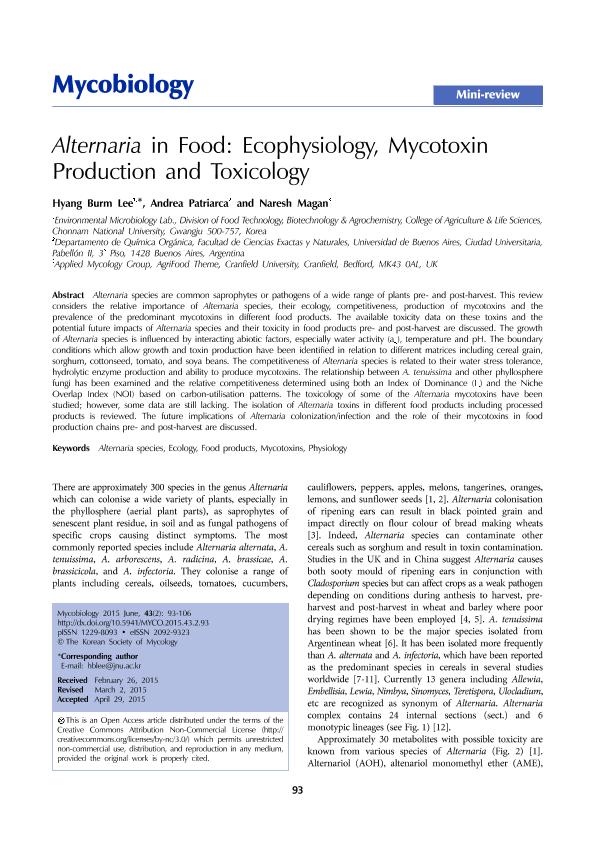Mostrar el registro sencillo del ítem
dc.contributor.author
Lee, Hyang Burm

dc.contributor.author
Patriarca, Andrea Rosana

dc.contributor.author
Magan, Naresh

dc.date.available
2017-05-10T18:39:36Z
dc.date.issued
2015-06-30
dc.identifier.citation
Lee, Hyang Burm; Patriarca, Andrea Rosana; Magan, Naresh; Alternaria in Food: Ecophysiology, Mycotoxin Production and Toxicology; Korean Society of Mycology; Mycobiology; 43; 2; 30-6-2015; 93-106
dc.identifier.issn
1229-8093
dc.identifier.uri
http://hdl.handle.net/11336/16228
dc.description.abstract
Alternaria species are common saprophytes or pathogens of a wide range of plants pre- and post-harvest. This review considers the relative importance of Alternaria species, their ecology, competitiveness, production of mycotoxins and the prevalence of the predominant mycotoxins in different food products. The available toxicity data on these toxins and the potential future impacts of Alternaria species and their toxicity in food products pre- and post-harvest are discussed. The growth of Alternaria species is influenced by interacting abiotic factors, especially water activity (aw), temperature and pH. The boundary conditions which allow growth and toxin production have been identified in relation to different matrices including cereal grain, sorghum, cottonseed, tomato, and soya beans. The competitiveness of Alternaria species is related to their water stress tolerance, hydrolytic enzyme production and ability to produce mycotoxins. The relationship between A. tenuissima and other phyllosphere fungi has been examined and the relative competitiveness determined using both an Index of Dominance (ID) and the Niche Overlap Index (NOI) based on carbon-utilisation patterns. The toxicology of some of the Alternaria mycotoxins have been studied; however, some data are still lacking. The isolation of Alternaria toxins in different food products including processed products is reviewed. The future implications of Alternaria colonization/infection and the role of their mycotoxins in food production chains pre- and post-harvest are discussed.
dc.format
application/pdf
dc.language.iso
eng
dc.publisher
Korean Society of Mycology
dc.rights
info:eu-repo/semantics/openAccess
dc.rights.uri
https://creativecommons.org/licenses/by-nc-sa/2.5/ar/
dc.subject
Alternaria Species
dc.subject
Ecology
dc.subject
Physiology
dc.subject
Mycotoxins
dc.subject
Food Products
dc.subject.classification
Alimentos y Bebidas

dc.subject.classification
Otras Ingenierías y Tecnologías

dc.subject.classification
INGENIERÍAS Y TECNOLOGÍAS

dc.title
Alternaria in Food: Ecophysiology, Mycotoxin Production and Toxicology
dc.type
info:eu-repo/semantics/article
dc.type
info:ar-repo/semantics/artículo
dc.type
info:eu-repo/semantics/publishedVersion
dc.date.updated
2017-05-02T18:17:20Z
dc.journal.volume
43
dc.journal.number
2
dc.journal.pagination
93-106
dc.journal.pais
Corea del Sur

dc.description.fil
Fil: Lee, Hyang Burm. Chonnam National University. College of Agriculture & Life Sciences. Division of Food Technology, Biotechnology & Agrochemistry. Environmental Microbiology Lab; Corea del Sur
dc.description.fil
Fil: Patriarca, Andrea Rosana. Universidad de Buenos Aires. Facultad de Ciencias Exactas y Naturales. Departamento de Química Orgánica; Argentina
dc.description.fil
Fil: Magan, Naresh. University Of Cranfield; Reino Unido
dc.journal.title
Mycobiology
dc.relation.alternativeid
info:eu-repo/semantics/altIdentifier/url/https://synapse.koreamed.org/DOIx.php?id=10.5941/MYCO.2015.43.2.93
dc.relation.alternativeid
info:eu-repo/semantics/altIdentifier/doi/http://dx.doi.org/10.5941/MYCO.2015.43.2.93
Archivos asociados
